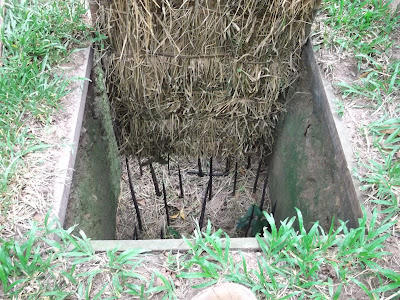 |
| Photo 1: Air holes for breathing underground. |
 |
| Photo 2: Booby trap made out of bamboo. |
 |
| Photo 3: Temple sides has arches similar to the ones at the Islamic Mosque. |
 |
| Photo 4: The Cao Dai Temple, the architecture has a symmetry. |
What have we learnt:
1 The fusion of the Eastern and Western cultures and religion in Cao Dai Temple can be seen through the arrangement of structures and the decorative. Examples of the arrangement of structures adapted from the West are the symmetrical arrangement of the 28 pillars, the balconies, the front structures and the tall figure (much like Notre Dame Cathedral), and the arches (Islamic Mosque). Examples of the decorative adapted from the West includes the ceiling painted with clouds and stars. Those adapted from the East includes the supernatural animals, as well as the colours used (yellow, blue, red). They believe that the Left Eye is closer to the heart which signifies the Yang, seeing everything that people do.
2 The complexity of the Cu Chi tunnels, booby traps and how the Liberation Army (Viet Cong) used guerrilla warfare to defeat the Americans. The traps were carved by bamboo sticks for spikes, they had air holes coming out of the ground to breathe and smoke vents. There was also an underground well where the Vietnamese soldiers could get clean water, as Americans polluted the water. The tunnels are unusually small; only the size of a Vietnamese back then could get through. The entrances, landmines and bunks are very well-covered with twigs and dead leaves, leaving the Americans extremely susceptible to the Vietnamese and have no knowledge in Guerrilla Warfare. This shows that the Vietnamese were very intelligent and had great team spirit and morale to get America's remnants of bomb shells and create their own weapons.
3 The Cao Dai Temple, although seems well-planned and intricate, has no master plans made before the building was constructed. It was constructed without architects or professionals, but rather local farmers. Hence it took 5 years to construct. After the building was done up, the government requested for its master planning, which then the people started to take measurements of the building and put it back into "planning stage". Our group observed that there were a lot of sand and the prayers wore a white costume.
Good reflection points. Number 3 is totally new to me though. :D
ReplyDelete